Drought and Deluge: Life in the Stream
Late afternoon in the second week of July, the canyon is parched after three months of drought. A hot breeze drifts up the desiccated streambed, rustling crisp leaves fallen among the stones, and riffling the few shrunken pools, crowded with agitated fish. A massive cloud looms above the canyon walls, toward the summit of the Santa Catalina Mountains. At sunset the cliffs echo the rumbling of a distant thunderstorm.
The next morning a muddy, leaf filled torrent bursts into Sabino Canyon. It pours into each empty pool, fills it, and rushes on to the next, banging rocks together and jamming logs between boulders. Cascading down the canyon, the water startles birds into flight and routs an army of grasshoppers, beetles, and spiders from the streambed. By noon the foam-covered current has passed the canyon mouth and is racing away from the mountains toward the dry riverbeds of the Tucson Basin.
The stream is the mountain's gift to the desert, but the mountain is a fickle gift-giver. Sabino Creek begins beneath a canopy of firs at an elevation of nearly 9,000 feet, on the shady slopes of Mt. Lemmon. By the time it reaches the desert, 6,000 feet below and ten miles away (as the fish swims), it is a golden tea, steeped in pine needles and oak leaves. In late fall and winter, when melting snow feeds its headwaters, and in spring, when snow gives way to rain, the creek flows generously through Sabino Canyon. But during the hot fore-summer months of May and June, Sabino Creek sinks beneath the sand and boulders and flows mostly underground, appearing only as a broken string of murky pools. The stream is abruptly replenished in mid-summer by monsoon thundershowers, only to dry out again in the after-summer drought of September and October.
This is the pattern, but it exists only in the endless variations created by an unpredictable desert climate. Amid all this uncertainty, life not only persists but thrives in Sabino Creek.
An Underwater "Grassland"
Sabino Creek is far more than a watercourse; it is an ecosystem, with miniature examples of the plants, herbivores, and carnivores found in ecosystems anywhere on earth. In some ways the stream is like an African grassland. Its "grasses" are the algae coating the rocks in a slippery layer, making them hazardous to unwary waders. At times these usually inconspicuous plants bloom into waving green mats.
The "grazers" are mostly aquatic snails, tadpoles, and the immature forms (larvae and nymphs) of flying insects such as midges, mosquitoes, and mayflies. Like grazing animals everywhere, many of these tiny creatures are beautifully camouflaged, blending so well into the background of the streambed that we seldom see them. They graze not only on the algae, but also on a fine stream-bottom detritus, composed of the decaying remnants of plants, aquatic animals, and animal droppings. Leaves falling into the stream from trees on its banks add greatly to this nutritious muck, upon which much of the life of the stream depends.
The "grazers" of Sabino Creek are fed upon in turn by a fierce assemblage of carnivores, the "lions" of the stream. Dull-colored dragonfly nymphs, camouflaged by a growth of algae, stalk or lie in wait for their prey, then snare them with lightning-quick unfolding mouthparts. Fast-swimming predaceous diving beetles chase down their prey Even their larvae are voracious carnivores; appropriately called water tigers, they grasp their victims in curved jaws, inject a digestive venom, then suck out their juices.
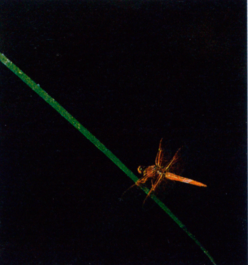
Many flying insects near the stream begin their lives as aquatic larvae or nymphs.
GILA CHUB
One of the great values of the mountain canyons of southeastern Arizona is in providing refuges for plants and animals that are threatened or have disappeared in other habitats. Sabino Canyon is such a refuge for the Gila chub. This unusual fish was once widespread through the Gila River and its tributaries, but habitat destruction and competition from introduced species have reduced its range to fewer than fifteen of Arizona's streams. It is officially listed by the state as threatened.
Fortunately, Gila chub still thrive in Upper Sabino Canyon. Except during the coldest months of the year, when they are mostly inactive and hidden among the rocks, they are easily seen moving about in the stream, the smallest usually in the shallows at the edges of pools and the larger adults in deeper water. They feed on aquatic insects, on other insects that fall into the water, and on algae. They are often mistaken for trout.
The Gila chub is the only native fish in Sabino Creek today. All others have been eliminated by the introduction of exotic species, a serious problem that has plagued native fishes throughout the West. The two most commonly seen exotics in the creek today are the green sunfish and the mosquitofish.
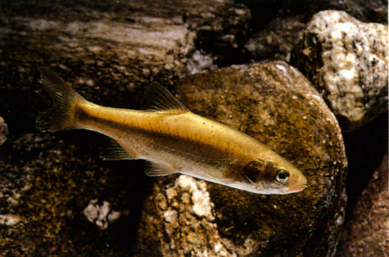

Winter evening light in a rock-lined pool
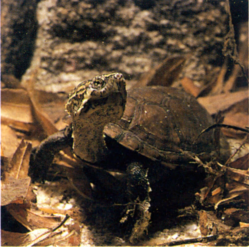
Sonoran mud turtle
Crayfish are the "vultures" of Sabino Creek, feeding on the dead remains of other aquatic animals, though they also eat living and dead plants, and sometimes small living animals, such as snails. They have even been seen snatching unsuspecting wasps drinking at the water's edge. A few of the stream's inhabitants have no counterparts in a grassland. The larger fishes and the Sonoran mud turtle occasionally seen basking on the shore are "super-predators" that feed on both the grazers and the smaller carnivores.
Superficial Lives
Sabino Creek's surface is a special habitat in itself, home to a variety of predators competing for flying insects that fall into the water. Schools of mosquitofish patrolling just below the surface belong to this community, as do several aquatic insects highly adapted to life in a world of waves and ripples.
Water striders skate lightly across the surface, their long legs spreading out their weight, keeping them from sinking through the membrane like surface tension layer. They detect their prey by sensing the ripples caused by their struggles and communicate with each other by vibrating their legs, creating special wave patterns signaling aggression or courtship.
Backswimmers are like upside-down water striders living on the underside of the surface. They swim under water by breathing air carried on their bodies —a natural scuba system. They float upward from time to time to replenish their air supplies and press their feet against the underside of the surface tension layer, feeling for the ripples that reveal their prey.
Shiny black whirligig beetles live neither above nor below the surface but straddle the surface itself. Their two eyes are each divided in half, giving them in effect four eyes, one pair looking upward into the air, the other downward into the water. As they race across the water they wrinkle up the surface ahead of them, and their antennae detect ripples reflected back by objects, as bats sense their surroundings and locate their prey through echoed sound waves.
Surviving the Extremes
All these creatures must contend not only with each other, but also with the capricious stream itself: the opposite challenges of drought and deluge.
Sabino Creek's inhabitants have a variety of strategies for dealing with drought. Tree frogs, toads, and many insects live in the water only in their immature stages. They can escape by transforming into adults and hopping or flying away — if they time it right. Even many insects that remain aquatic as adults, such as predaceous diving beetles, are able to fly away and seek water elsewhere when the stream dries out.
Animals that cannot leave the streambed face a more difficult problem. Aquatic snails seal themselves inside their shells with waterproof doors formed of their own dried secretions. In spite of this, they may cook if stranded in the sun. Fishes and crayfishes retreat to the few remaining pools, which may contain enough water to last through the drought. As the water level falls, these pools become more and more crowded. If the water disappears, the fish die, suffocating helplessly as their gills dry out, but the crayfish may survive a few days longer by burrowing into the moist sand. Then they face another danger as well: The drying creekbed is often littered with their half-eaten bodies, scattered among the tracks of raccoons. Some aquatic animals do perish during the drought, but enough always survive to repopulate the creek quickly when the water returns.
Spectacular as they may be, floods are briefer events than droughts in Sabino Canyon, and they take a lesser toll. Small creatures, such as snails and many aquatic insects, withstand the rapid current by clinging tightly to rocks. For example, mayfly nymphs have feet like tiny grappling hooks, and flattened bodies that they press close to the rock, staying in a thin boundary layer where the water moves more slowly. Fishes seek shelter between boulders, and crayfishes wedge themselves under rocks with their strong legs. In the long term, most aquatic animals actually benefit from a flood. Nutrients imported from the mountain by flood waters fertilize the plants that are the creatures' ultimate source of food.
CANYON TREEFROG
Visitors soaking up the desert sun on the boulders of Sabino Creek are often completely unaware of smaller creatures basking only a few feet away. These diminutive sunbathers are canyon tree frogs, amphibians that survive by masquerading as stones.
Canyon tree frogs frequently spend the day clinging to smooth stone surfaces a hop or two from the water. Their mottled gray color is often such a perfect match for the rock that they seem to disappear. To complete the deception, they remain immobile for hours at a time, an adaptation called "protective stillness," practiced by many highly camouflaged animals, but which is carried to an extreme by canyon tree frogs — they may not move even when touched.
If discovered, a canyon treefrog has two further levels of defense. As it leaps from the rock it flashes patches of yellow skin usually hidden by its folded legs, startling a potential predator and sometimes fooling it into looking nearby for a yellow animal. Meanwhile the treefrog has turned back into a gray stone or taken refuge underwater. If a frog is caught, it discourages a predator with toxins secreted by its skin. (If you catch one, be sure to wash your hands; if this substance gets in your eyes, it can burn for hours.)
On rainy summer nights canyon tree frogs show another side of their personality, often hopping far from the stream in search of insect prey. Their bleating, sheeplike mating calls are most often heard in the canyon on evenings in April and during the summer monsoon.
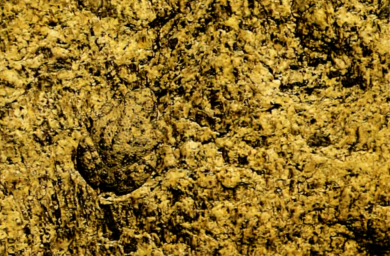
DESERT JELLYFISH
To come upon a pool filled with hundreds of miniature jellyfish, rising and falling gracefully through the water not twenty feet from saguaros and prickly pears, is enough to startle even the most experienced desert dweller.
"Freshwater jellyfish" are among the rarest and most remarkable inhabitants of Sabino Creek. Not true jellyfish, they are actually the jellyfishlike medusa stage in the life cycle of a little-known aquatic organism. These creatures spend most of their lives in another form, as colonies of minuscule polyps attached to submerged rocks. The medusae appear only occasionally, beginning as buds on the polyps, then detaching and floating free. No one fully understands the conditions that cause the medusae to form. In Sabino Canyon they appear unpredictably in still pools during prolonged periods of low water, the only times when they can live and grow without being washed away. They may become as large as an inch across, and seem to be ignored by fish, perhaps because their stinging tentacles make them unpalatable.
Like true jellyfish, these simple animals swim by pulsations of their bodies and capture prey with their tentacles. They feed on minute aquatic insects and crustaceans, and are quite harmless to people.

Freshwater jellyfish
A Well-Connected Ecosystem
One of Sabino Creek's pleasures is that it seems a world apart, a self-contained watery universe set incongruously between desert canyon walls. Yet the stream has strong ties to its surroundings: to the raccoon that feasts on its crayfish, to the tree that shades it from the hot desert sun, to the deer that takes a morning drink, to the mountain that supplies the gift of water itself.
For millions of years, Sabino Creek has joined other rivers and streams in filling a great aquifer beneath the Tucson Basin. Tucson could not have survived through the twentieth century without mining that ancient water supply, a deposit far more valuable than gold. In this way we, too, are connected to Sabino Creek.
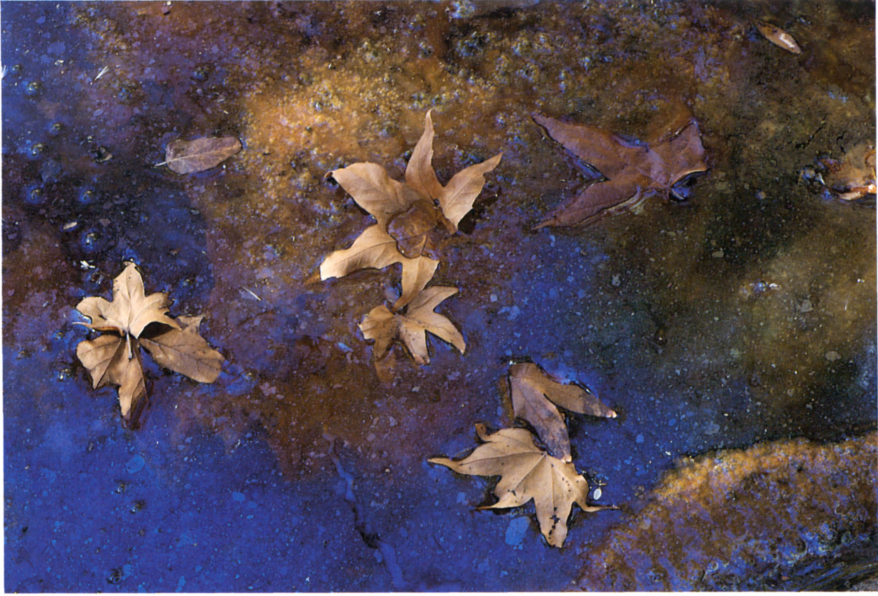
Algae and fallen sycamore leaves

A light snowfall dusts the desert's edge, high on a slope in Upper Sabino Canyon.